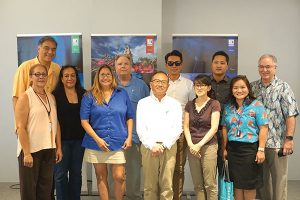LEARNING FROM THE WAIKIKI EXPERIENCE
‘It takes a village’

Rick Egged, president of Waikiki Improvement District Association, far right, poses with Marianas Visitors Authority officials and guests at the MVA membership meeting last Thursday at Kensington Hotel Saipan. (Bea Cabrera)
Waikiki, one of the most popular tourism destinations in the world, didn’t just happen that way.
It took the effort of an entire community to make Waikiki what it is now as a popular destination for travel and leisure, according to Rick Egged, president of the Waikiki Improvement District Association.
Speaking at the Marianas Visitor’s Authority general membership meeting last week, Egged said: “Waikiki today is the brainchild of the people, business community and the government.”
He said that community effort and planning moved everything for Waikiki. “There will always be conflicting goals from different sectors and the key is to try to have people discuss their ideas [and] options.
“…When you start making changes and people feel the positive effects, each change becomes easier to make because you have a good track record,” he added.
The Waikiki Improvement District Association, which Egged leads, works to enhance Waikiki’s physical, economic and cultural environment. It is dedicated to ensuring the coordinated management and long term sustainability of Waikiki Beach.
Saipan tourism is still a baby compared to how Waikiki tourism runs today and Egged is positive that the CNMI can be as popular as Waikiki, provided careful planning is at play.
“The problem is…each part of the government is doing what they think is important in their job,” Egged said. “A planning office is key to tie the pieces together, getting departments to talk to each other and coordinate their activities and having it become a part of a bigger plan.”
Egged said that building Waikiki as a tourist destination took years of learning and development that other places like the CNMI can learn from.
“We had to know Waikiki through and through in order to address what needs to be developed and improved on. We recognize that Waikiki Beach is our single and most important asset and so we started really caring for it,” he said.
“We used to lose one foot of beach a year to due to erosion and we successfully managed this by working with environmental groups and university students in keeping erosion at bay and one of the solutions that we implemented was to widen the shores,” he added.
According to Egged, Waikiki, with its diverse residents and visitors, was once notorious for burglary and theft and this reputation had to be erased.
“Crimes dropped when we established Aloha patrol officers who deter theft and advise tourists, added cameras on the roads and streets, implemented intelligence-led policing, foot patrols and stationary posts, community policing and better lighting. We also addressed other issues like homelessness by putting the homeless in housing. Instead of building parking spaces, we built a good transportation system,” he said.
“We have people that clean the streets of Waikiki 24/7 weekly by pressure-washing the streets and gum removals. For last year alone, we mopped 30,000 spills, erased 5,000 graffiti, and collected 16,000 bags of trash. These and more are being done every day to make Waikiki an ideal destination,” he added.
One of the things that make Waikiki unique is that they were successful in “restoring its Hawaiiness.”
“Restoring cultural awareness was something that we worked on extensively in Waikiki because…your unique culture is something that visitors are interested in seeing and sharing,” he said.
“A visitor industry creates a market that can keep alive some of those cultural activities that might die out otherwise.
“…If visitors can participate just by observation or join workshops, whether as dance or crafts, the visitor’s industry can actually be helpful in keeping alive traditions that would otherwise die out,” he added.
At the end of the day, Egged said the success of Waikiki is based on good stewardship.
“Good stewardship and engaging stakeholders in the community are key elements because, for the visitor industry to be successful, it needs to be engaged with the community. This is one of our secrets to succeeding in Waikiki,” he said.
“It all boils down to don’t give up, keep trying and even if it is a small thing, do that first so that you create the momentum for further change. If it happened for Waikiki, it can also definitely happen for the CNMI,” he added.



























